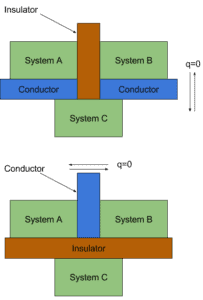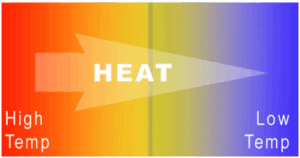Zeroth Law of Thermodynamics

We can discover an important property of thermal equilibrium by considering three systems. A, B, and C, that initially are not in thermal equilibrium. We separate systems A and B with an adiabatic wall (ideal insulating material), but we let system C interact with both systems A and B. We wait until thermal equilibrium is reached; then A and B are each in thermal equilibrium with C. But are they in thermal equilibrium with each other?
According to many experiments, there will be no net energy flow between A and B. This is an experimental evidence of the following statement:
If two systems are both in thermal equilibrium with a third then they are in thermal equilibrium with each other.
This statement is known as the zeroth law of thermodynamics. It has this unusual name because it was not until after the great first and second laws of thermodynamics were worked out that scientists realized that this apparently obvious postulate needed to be stated first.
 This law provides a definition and method of defining temperatures, perhaps the most important intensive property of a system when dealing with thermal energy conversion problems. Temperature is a property of a system that determines whether the system will be in thermal equilibrium with other systems. When two systems are in thermal equilibrium, their temperatures are, by definition, equal, and no net thermal energy will be exchanged between them. Thus the importance of the zeroth law is that it allows a useful definition of temperature.
This law provides a definition and method of defining temperatures, perhaps the most important intensive property of a system when dealing with thermal energy conversion problems. Temperature is a property of a system that determines whether the system will be in thermal equilibrium with other systems. When two systems are in thermal equilibrium, their temperatures are, by definition, equal, and no net thermal energy will be exchanged between them. Thus the importance of the zeroth law is that it allows a useful definition of temperature.
We hope, this article, Zeroth Law of Thermodynamics, helps you. If so, give us a like in the sidebar. Main purpose of this website is to help the public to learn some interesting and important information about thermal engineering.